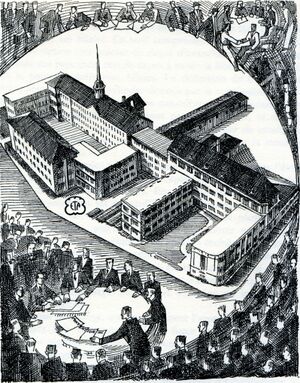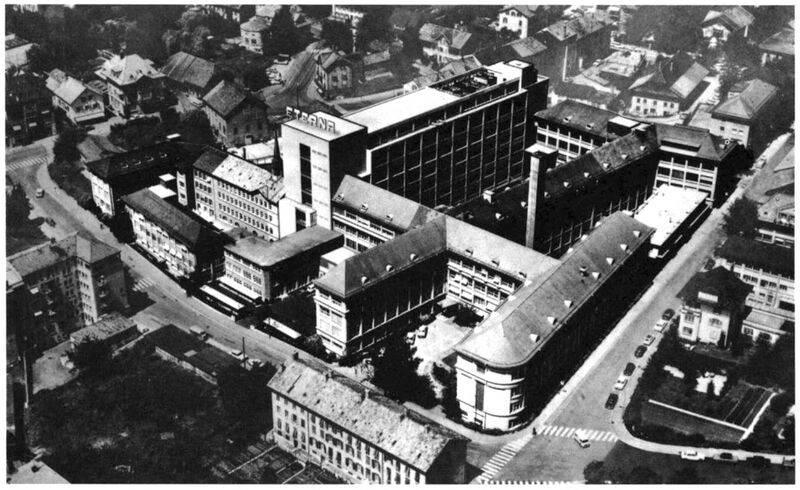Fabrikstrasse: Difference between revisions
Created page with "Fabrikstrasse is the historic name of the Eterna factory complex in Grenchen, now called Schild-Rust-Strasse after Urs Schild-Rust who established the firm there. Today the factory complex at Schild-Rust-Strasse is the headquarters of ETA. ==History== The complex began in 1856 as the home of the firm Girard & Schild, established by Dr. Josef Girard and teacher Urs Schild-Rust (1829-1888). This was a successor to the firm Girard Frères & K..." |
No edit summary |
||
| (3 intermediate revisions by the same user not shown) | |||
| Line 1: | Line 1: | ||
[[File:Eterna Grenchen Engraving.jpeg|right|300px]] | |||
Fabrikstrasse is the historic name of the [[Eterna]] factory complex in [[Grenchen]], now called Schild-Rust-Strasse after [[Urs Schild-Rust]] who established the firm there. Today the factory complex at Schild-Rust-Strasse is the headquarters of [[ETA]]. | Fabrikstrasse is the historic name of the [[Eterna]] factory complex in [[Grenchen]], now called Schild-Rust-Strasse after [[Urs Schild-Rust]] who established the firm there. Today the factory complex at Schild-Rust-Strasse is the headquarters of [[ETA]]. | ||
| Line 10: | Line 11: | ||
Following the [[1969]] takeover of [[Felsa]] and [[1978]] merger of ETA and [[ASSA]], ETA employed 35% of the total workforce in the Grenchen area. But the firm increasingly focused on automation with the [[Swatch]] and employment fell in the following decade despite ETA emerging as the sole producer of most watch movements in the 1990s. | Following the [[1969]] takeover of [[Felsa]] and [[1978]] merger of ETA and [[ASSA]], ETA employed 35% of the total workforce in the Grenchen area. But the firm increasingly focused on automation with the [[Swatch]] and employment fell in the following decade despite ETA emerging as the sole producer of most watch movements in the 1990s. | ||
[[File:Davoine 1923 0882 Eterna factory.jpg|center|800px|thumb|A view of the Eterna factory in a 1922 advertisement]] | |||
==Buildings== | ==Buildings== | ||
| Line 25: | Line 28: | ||
* XI: Numerous large buildings were added north of the original complex in the 1950s and 1960s. | * XI: Numerous large buildings were added north of the original complex in the 1950s and 1960s. | ||
* XII and XIII: Two old farmhouses were included in the complex around 1900 and converted to workshops, but were later demolished. | * XII and XIII: Two old farmhouses were included in the complex around 1900 and converted to workshops, but were later demolished. | ||
[[File:1977 Eterna Factory.jpg|center|800px|thumb|A view of the Eterna complex from a 1977 ad]] | |||
==See Also== | |||
* [[Mühlestrasse]] ([[A. Schild]]) | |||
* [[Schützengasse]] ([[A. Michel]]) | |||
* [[Schmelzi]] ([[Obrecht & Cie]]) | |||
[[Category:Grenchen]] | [[Category:Grenchen]] | ||
[[Category:Eterna]] | [[Category:Eterna]] | ||
[[Category:ETA]] | [[Category:ETA]] | ||
Latest revision as of 01:01, 1 May 2024

Fabrikstrasse is the historic name of the Eterna factory complex in Grenchen, now called Schild-Rust-Strasse after Urs Schild-Rust who established the firm there. Today the factory complex at Schild-Rust-Strasse is the headquarters of ETA.
History
The complex began in 1856 as the home of the firm Girard & Schild, established by Dr. Josef Girard and teacher Urs Schild-Rust (1829-1888). This was a successor to the firm Girard Frères & Kunz. In 1864 Schild's brother Adolf joined the business, and the Schild family ran it alone after the retirement of Dr. Girard in 1866.
The business flourished, with increasing use of advanced machine tools and vertical integration. The demands of the factory lead to the building of a canal to the factory in 1885.
After the 1888 death of Urs Schild the business was reorganized in 1891 under the name Gebr. Schild & Co. His son Max Schild ran the firm along with his mother Elisabeth Shild-Rust and brothers Theodor and Walter. Following labor difficulties, including a general strike in 1897, Theodor Schild took over in 1899 and lead the company until it was integrated into ASUAG and Ebauches SA in 1932 as Eterna and ETA, respectively.
Following the 1969 takeover of Felsa and 1978 merger of ETA and ASSA, ETA employed 35% of the total workforce in the Grenchen area. But the firm increasingly focused on automation with the Swatch and employment fell in the following decade despite ETA emerging as the sole producer of most watch movements in the 1990s.

Buildings

- I: The first building of the complex was built in 1856-1857 on the what was then the road to Kastels. It included 6 work rooms as well as a machine shop with an overshot water wheel. An underground canal was built around 1860 by Geom. K. Feller, and the factory power was later supplemented with a steam engine ("Lokomobil"). This first building was demolished in 1941 and rebuilt, only to be demolished again in 1973.
- II: An extension building was added in 1870 for 300-400 workers. It was a long wing with three workshop floors under a gable roof featuring an iconic turret with a factory bell. It was connected to building I by a gallery and featured a large steam engine from Sulzer in Winterthur. Around 1940 it was extended to the west. This wing was demolished in 1973 and re-built.
- III: The pinion workshop was built around 1870. It was a 2-story annex with a flat roof and was later extended. It was demolished in 1973.
- IV: The L-shaped wing connected buildings I and II in 1904, replacing the earlier gallery. It had 3 floors under a flat roof. It was demolished in 1973.
- V: The long narrow northern annex was built around 1900 as a warehouse and dorage. It was later extended but was demolished in 1973.
- VI: The carpentry shop, built around 1900, was replaced by a larger annex around 1940. It was demolished in 1973.
- VII: The 4-story office and workshop was built in 1914 as an extension of Building II. It has a flat roof, unlike the gabled western neighbor.
- VIII: This extended building features two wings at 90 degree angles, one with a hip roof and other with a flat roof. It was built in 1918 by Carl Burkhard.
- IX: The “welfare house” was built in 1946 along Kapellstrasse. It features canteens for the workers.
- X: The workers' home was built in 1946 at the western edge of the factory and was demolished in 1973.
- XI: Numerous large buildings were added north of the original complex in the 1950s and 1960s.
- XII and XIII: Two old farmhouses were included in the complex around 1900 and converted to workshops, but were later demolished.
